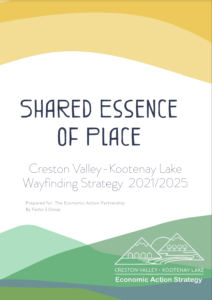 Strategy: Lead the incremental enhancement of wayfinding resources to build regional momentum and unity around a shared brand that reflects the principles of Reconciliation.
Strategy: Lead the incremental enhancement of wayfinding resources to build regional momentum and unity around a shared brand that reflects the principles of Reconciliation.
Creston Valley-Kootenay Lake covers an expanse of land where the Ktunaxa have lived since time immemorial. The arrival of settlers in the Valley and along the shore of Kootenay Lake disrupted their sovereignty and forever changed their wayfinding systems. The Creston Valley Kootenay Lake Economic Action Partnership, (EAP), developed the CRESTON VALLEY-KOOTENAY LAKE WAYFINDING STRATEGY: ESSENCE OF PLACE as an opportunity to forge a shared regional vision of a wayfinding system that connects travelers with the essence of place and people. The strategy mobilizes partners and resources around a shared vision of Wayfinding deeply rooted in Yaquan Nukiy Culture. The Wayfinding strategy leads the incremental enhancement of wayfinding resources to build regional momentum and unity around a shared brand that reflects the Principles of Reconciliation.
This project developed a wayfinding system that strengthened the common sense of identity in the CKLV area while building support for further economic development. Its overarching strategy is designed to complement and support the economic and social goals of the CVKL EAP. The project helps to support thriving local business and tourism sectors by enhancing the visitor experience, attracting new business investment, while raising awareness of the area’s public amenities and attractions. Most importantly, it establishes a foundation for the regional district, town and First Nation to begin constructive dialogue that can lead to closer collaboration based on mutual respect, understanding and shared values.
Wayfinding as an act of reconciliation can create the foundation for new dialogue on how communities move forward together. By balancing immediate tactical priorities with long-term authentic relationship building and sharing of lived experience, communities can establish a renewed sense of place and purpose.
It is our hope that similar approaches will be implemented in every community across North America. The incorporation of Indigenous Wayfinding is one way to acknowledge that we are all on indigenous lands, and tell residents, visitors and future generations not only what is here now, how to support local businesses and find special local places, but something much deeper about the place they are in. It can help us evolve the Canadian narrative towards reconciliation.
The main lesson learned is that it is crucial to engage with local indigenous communities to develop honest and useful wayfinding systems in Canada.